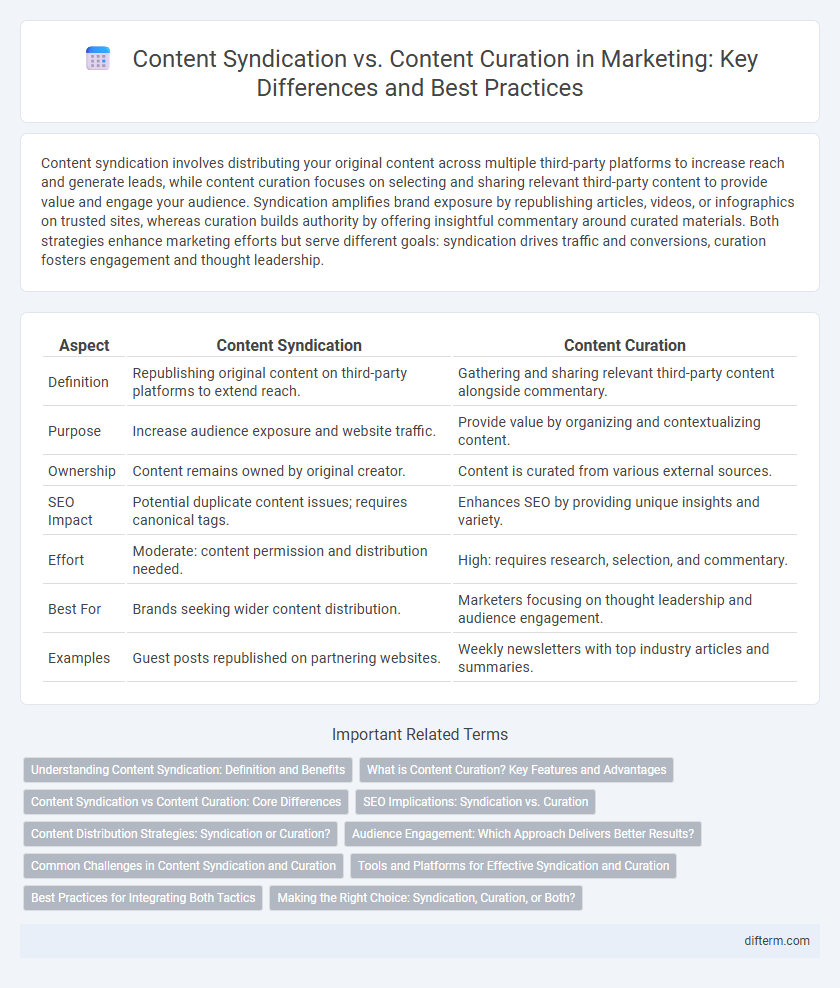Content syndication involves distributing your original content across multiple third-party platforms to increase reach and generate leads, while content curation focuses on selecting and sharing relevant third-party content to provide value and engage your audience. Syndication amplifies brand exposure by republishing articles, videos, or infographics on trusted sites, whereas curation builds authority by offering insightful commentary around curated materials. Both strategies enhance marketing efforts but serve different goals: syndication drives traffic and conversions, curation fosters engagement and thought leadership.
Table of Comparison
| Aspect | Content Syndication | Content Curation |
|---|---|---|
| Definition | Republishing original content on third-party platforms to extend reach. | Gathering and sharing relevant third-party content alongside commentary. |
| Purpose | Increase audience exposure and website traffic. | Provide value by organizing and contextualizing content. |
| Ownership | Content remains owned by original creator. | Content is curated from various external sources. |
| SEO Impact | Potential duplicate content issues; requires canonical tags. | Enhances SEO by providing unique insights and variety. |
| Effort | Moderate: content permission and distribution needed. | High: requires research, selection, and commentary. |
| Best For | Brands seeking wider content distribution. | Marketers focusing on thought leadership and audience engagement. |
| Examples | Guest posts republished on partnering websites. | Weekly newsletters with top industry articles and summaries. |
Understanding Content Syndication: Definition and Benefits
Content syndication involves distributing original content across third-party platforms to expand reach and drive targeted traffic back to the source website. This strategy enhances brand visibility, generates qualified leads, and improves SEO by leveraging established audiences on reputable sites. Marketers benefit from increased content lifespan and greater engagement without creating additional content assets.
What is Content Curation? Key Features and Advantages
Content curation involves gathering, organizing, and sharing relevant content from various sources to provide value to a target audience, enhancing brand authority and audience engagement. Key features include selective content filtering, personalized commentary, and consistent publication that aligns with brand messaging. Advantages encompass increased audience trust, improved SEO through diverse content, and efficient resource use compared to creating original content from scratch.
Content Syndication vs Content Curation: Core Differences
Content syndication involves distributing your original content across third-party platforms to amplify reach and generate leads, while content curation focuses on selectively gathering and sharing relevant external content to engage and inform your audience. Syndication prioritizes content ownership and control with consistent branding, whereas curation emphasizes adding value through commentary and contextualization of others' content. Understanding these core differences helps marketers choose the right strategy for expanding brand visibility versus building thought leadership.
SEO Implications: Syndication vs. Curation
Content syndication distributes identical content across multiple platforms, potentially causing duplicate content issues that can harm SEO rankings unless proper canonical tags are implemented. Content curation involves selectively aggregating and adding unique commentary to existing content, enhancing SEO by providing fresh, relevant information that attracts backlinks and user engagement. Choosing between syndication and curation depends on balancing reach expansion and maintaining original, authoritative content for search engines.
Content Distribution Strategies: Syndication or Curation?
Content syndication involves republishing your original content on third-party platforms to expand reach and drive traffic back to your site, while content curation focuses on selecting and sharing relevant third-party content to engage your audience. Syndication amplifies brand visibility and SEO by leveraging authoritative sites, whereas curation builds trust and positions your brand as a thought leader through consistent value delivery. Choosing between these strategies depends on your marketing goals: syndication targets audience growth and direct engagement metrics, while curation enhances brand awareness and community interaction.
Audience Engagement: Which Approach Delivers Better Results?
Content syndication distributes original content across multiple platforms to expand reach, driving higher audience engagement through increased visibility and consistent messaging. Content curation involves selecting and sharing relevant third-party content, fostering trust and interaction by providing diverse perspectives tailored to audience interests. Businesses aiming for scalable exposure often benefit more from syndication, while those prioritizing community building and thought leadership leverage curation for deeper engagement.
Common Challenges in Content Syndication and Curation
Content syndication and content curation often face challenges such as maintaining content originality and ensuring proper attribution to avoid copyright issues. Both methods require consistent quality control to prevent brand dilution and preserve audience trust. Managing the balance between timely, relevant distribution and avoiding content oversaturation remains a critical concern for marketers.
Tools and Platforms for Effective Syndication and Curation
Content syndication leverages platforms such as Outbrain, Taboola, and LinkedIn Elevate to distribute original content widely, enhancing reach and driving targeted traffic. Content curation benefits from tools like Feedly, Curata, and Scoop.it, which help marketers discover, organize, and share relevant third-party content that aligns with audience interests. Choosing the right combination of syndication and curation tools maximizes content impact, boosts brand authority, and improves audience engagement metrics.
Best Practices for Integrating Both Tactics
Combining content syndication and content curation enhances brand visibility and audience engagement by distributing original content while selectively sharing relevant third-party materials. Best practices include aligning curated content with audience interests to maintain relevance, leveraging syndication networks to amplify reach, and consistently analyzing performance metrics to optimize content mix. This integrated approach drives authority and builds trust, fostering long-term customer relationships and boosting inbound marketing effectiveness.
Making the Right Choice: Syndication, Curation, or Both?
Content syndication amplifies reach by distributing original content across multiple platforms, enhancing brand visibility and driving targeted traffic, while content curation involves selecting and sharing relevant third-party content to engage audiences and establish thought leadership. Choosing syndication maximizes content exposure and SEO benefits, whereas curation fosters community trust and positions brands as industry experts. Combining both strategies creates a balanced approach, expanding reach while maintaining fresh, diverse content that resonates with varied audience segments.
Content Syndication vs Content Curation Infographic

 difterm.com
difterm.com